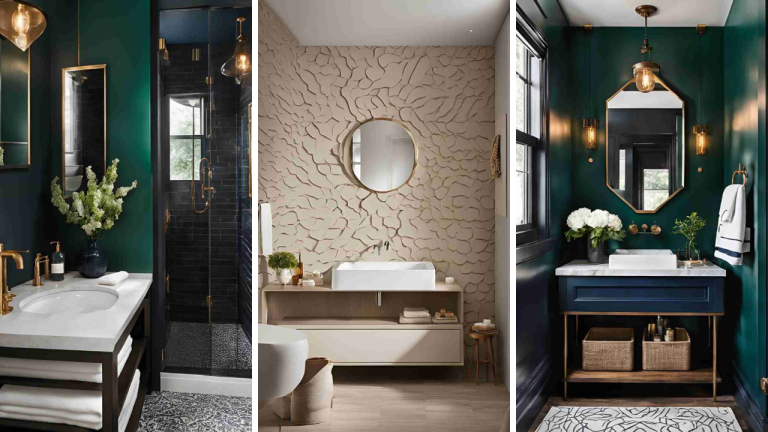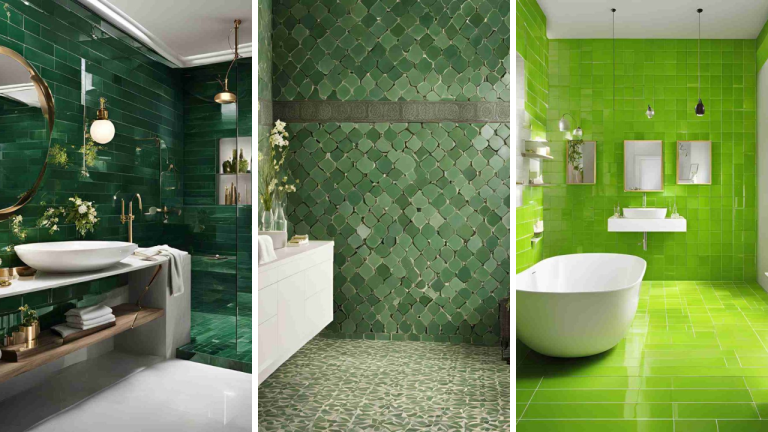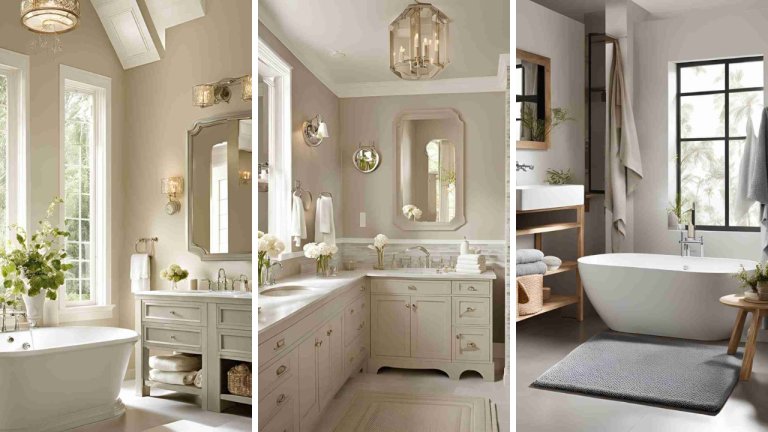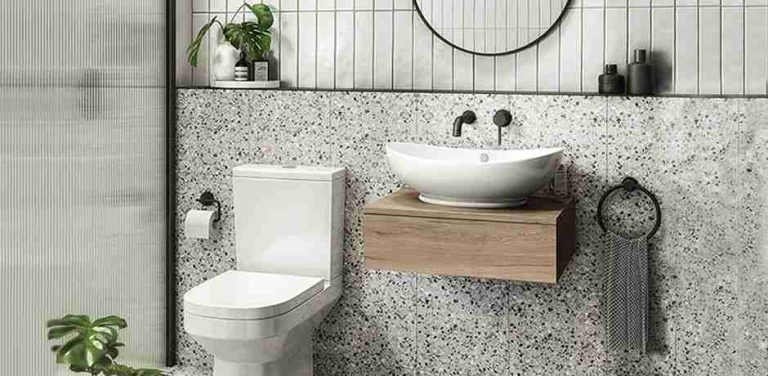When it comes to bathroom design, Japandi style is an incredible choice for creating a calming, minimalist sanctuary. A fusion of Japanese zen and Scandinavian functionality, Japandi effortlessly combines clean lines, neutral tones, and natural materials. If you’re looking to elevate your bathroom with a tranquil, stylish vibe, look no further than these 11 Japandi bathroom ideas.
Here, we’ve gathered some of the most innovative and inspiring ideas for incorporating Japandi elements into your bathroom design. Whether you’re working with a small powder room or a spacious master bath, these tips will help you craft the perfect space to unwind after a long day. Let’s dive into these ideas to transform your bathroom into a beautiful retreat!
1. Embrace a Neutral Color Palette
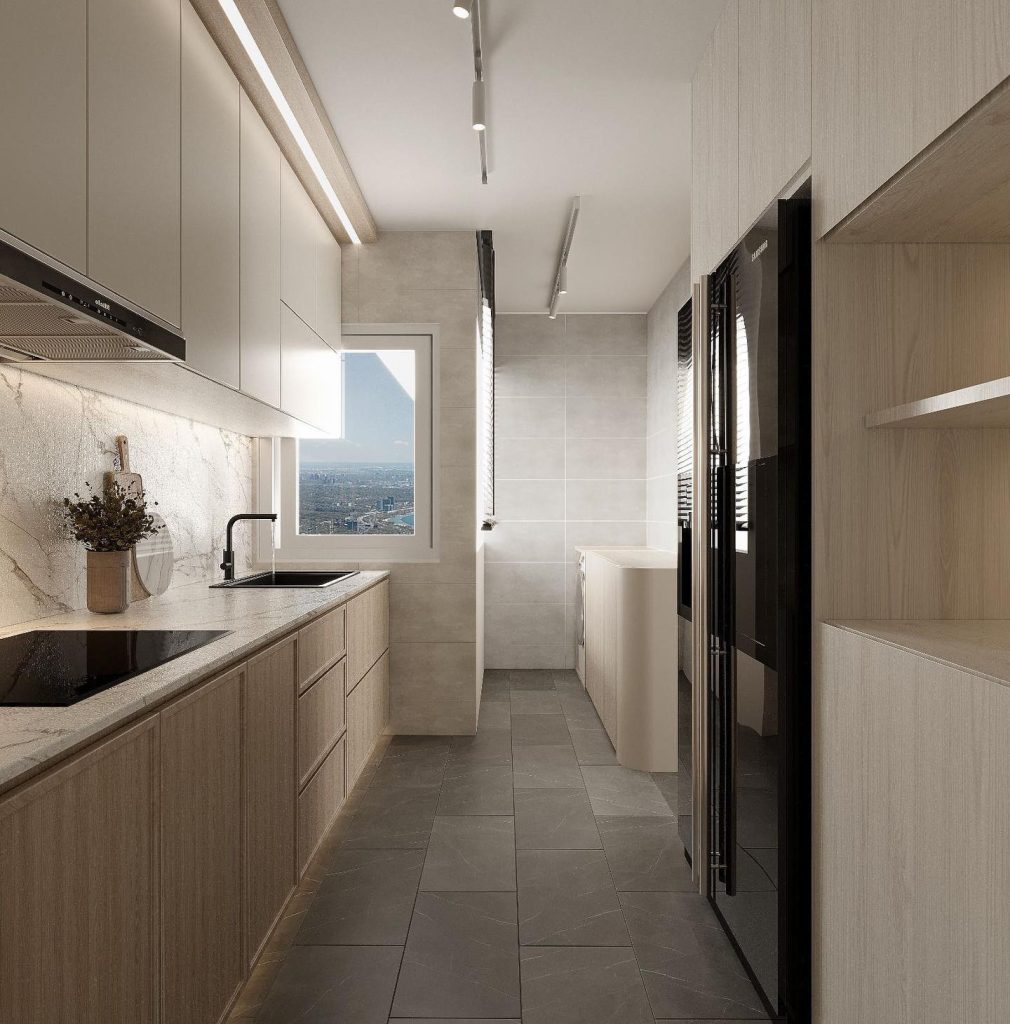
The foundation of a Japandi bathroom is its neutral color palette, which emphasizes calmness and balance. By sticking to soothing tones such as beige, soft grays, whites, and muted earth tones, you’ll create a peaceful atmosphere that is perfect for relaxation. Neutral colors allow you to combine elements from both Scandinavian and Japanese design without overwhelming the space.
To achieve a true Japandi feel, opt for soft, earthy colors for your walls and floors. Consider pale wooden tones for your flooring to add warmth, or neutral tiles like concrete or marble to give your bathroom an elegant yet understated touch. A combination of whites and light greys creates a serene backdrop, allowing for other features like plants and natural textures to stand out. The key is to avoid bright or bold hues that can disrupt the serene atmosphere you’re trying to create.
You can add depth to your neutral palette by incorporating different shades of the same color, using matte finishes for walls and high-gloss finishes for smaller accessories, such as mirrors or faucets. By using a neutral color scheme, you can focus on the materials and textures, which are central to Japandi style, without the need for busy patterns or bright colors.
2. Incorporate Natural Wood Accents
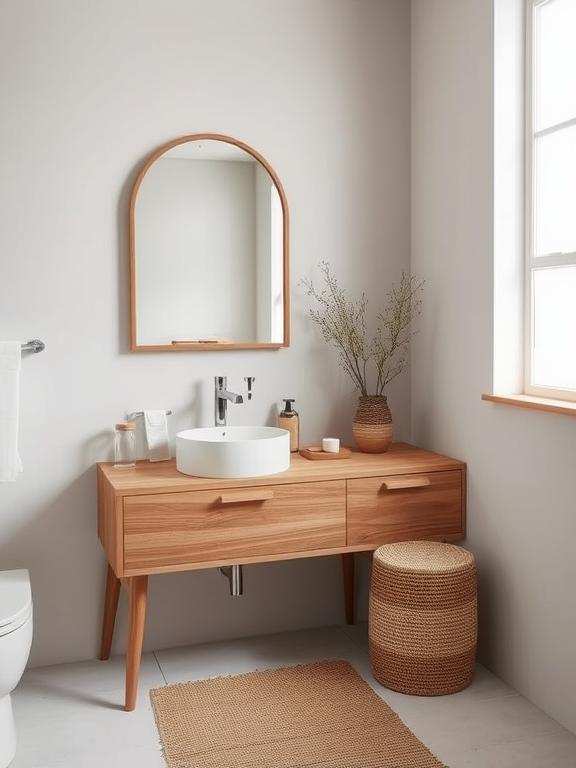
Source: Scandinavian Design Magazine
Wood is an essential element in Japandi bathrooms, as it adds warmth, texture, and a natural element to the space. Scandinavian design, with its love for light woods like oak or ash, blends perfectly with Japanese sensibilities, which focus on creating harmony with nature. When you introduce natural wood accents into your bathroom, you’ll bring a sense of tranquility and a grounded, earthy feel.
For your Japandi bathroom, consider wooden vanities, shelving, and even wooden shower mats. Light oak works well for a soft, Scandinavian vibe, while darker woods like walnut or bamboo can add a more robust, Japanese influence. Wood can be used sparingly to prevent the bathroom from feeling too heavy or rustic—small touches, like a wooden soap dish or a bamboo bath stool, can make a significant impact.
Incorporating wood into your bathroom also connects the space to nature, promoting a feeling of zen. If you’re working with limited space, consider using wood accents for functional items like towel racks, storage baskets, or framed mirrors. This way, you can introduce the warmth of wood without overwhelming the minimalist aesthetic.
3. Choose Sleek, Minimalist Fixtures
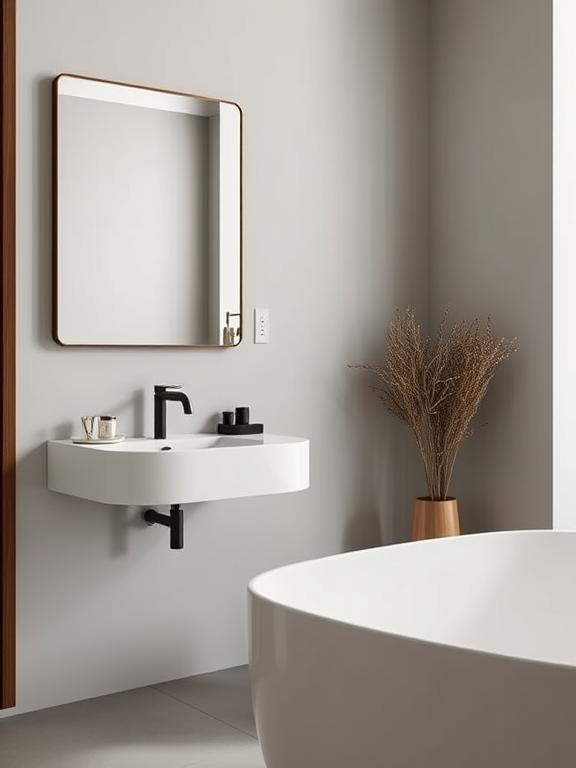
Source: Home & Design Journal
Japandi design is known for its sleek, clean lines, and minimalism, which extends to fixtures like faucets, mirrors, and showerheads. When choosing bathroom fixtures, prioritize simple and functional designs that don’t detract from the overall atmosphere. Wall-mounted faucets, floating vanities, and streamlined shower heads are great examples of Japandi-style fixtures that contribute to a minimalist aesthetic.
To keep things visually balanced, opt for matte black, brushed nickel, or brass finishes—these elements complement the neutral palette and natural textures, contributing to an elegant, refined look. For example, a black matte faucet or a simple white freestanding tub with a sleek design can create an understated yet luxurious atmosphere.
The beauty of Japandi fixtures lies in their subtlety. The focus isn’t on flashy, ornamental designs but rather on understated elegance. By selecting minimalist fixtures that focus on functionality, you’ll ensure that your bathroom remains a peaceful, uncluttered space.
4. Introduce Textured Stone Elements
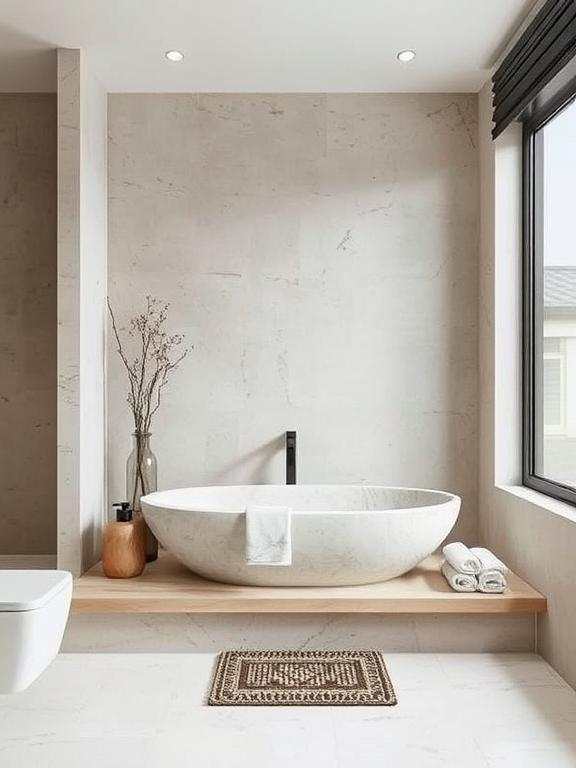
Source: Interior Design Weekly
Stone is another vital material that adds depth and texture to Japandi bathrooms. Whether used for countertops, flooring, or feature walls, stone brings a grounded, earthy quality to the space. From smooth marble surfaces to rustic slate tiles, stone elements can be used strategically to add both luxury and natural appeal to your bathroom design.
For a Japandi-inspired bathroom, choose natural stones like marble, travertine, or honed concrete. These materials evoke a sense of serenity, and their subtle texture contrasts beautifully with the soft wood elements found in the rest of the space. Stone sinks or bathtubs can also serve as stunning focal points while maintaining a minimalist aesthetic.
When using stone, aim for muted, neutral tones like white, gray, or beige to stay within the Japandi theme. By incorporating stone into your bathroom, you’ll enhance the connection to nature, creating a calming environment where you can unwind and refresh.
5. Soften the Space with Soft Lighting
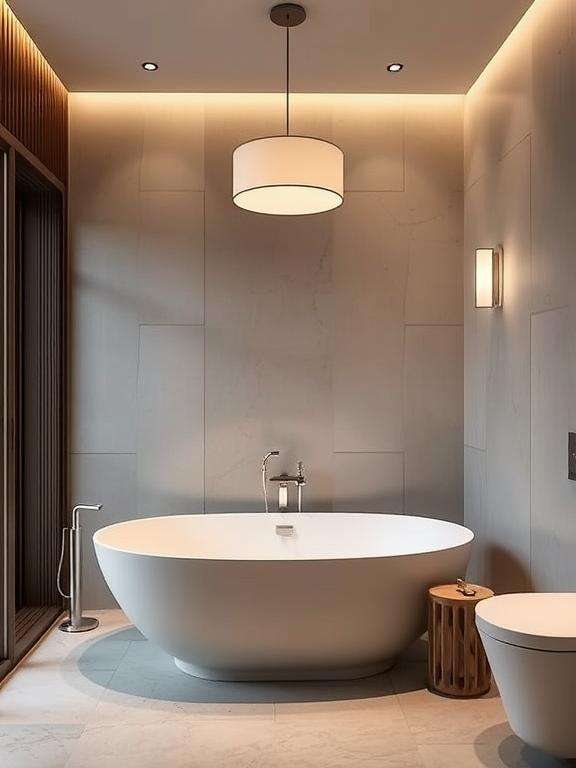
Source: Lighting Trends Magazine
Lighting plays a significant role in Japandi bathroom design, as it enhances the serene, spa-like atmosphere. Instead of harsh, bright overhead lights, aim for soft, warm lighting that creates a calming effect. Opt for fixtures that emit soft, diffused light, such as pendant lights, sconces, or recessed lighting. Warm LED lights are perfect for achieving that gentle glow that is characteristic of Japandi interiors.
For a truly tranquil bathroom, consider installing a dimmable light feature to adjust the ambiance based on your needs. Low lighting in the evening can help create a peaceful mood, while brighter lighting in the morning ensures you have enough visibility to start your day.
To keep things minimal, choose simple, clean light fixtures that blend seamlessly with the rest of the design. A modern pendant light above the bathtub or sconces by the mirror can provide both functional and aesthetic benefits, adding subtle elegance without overpowering the space.
6. Opt for a Freestanding Soaking Tub
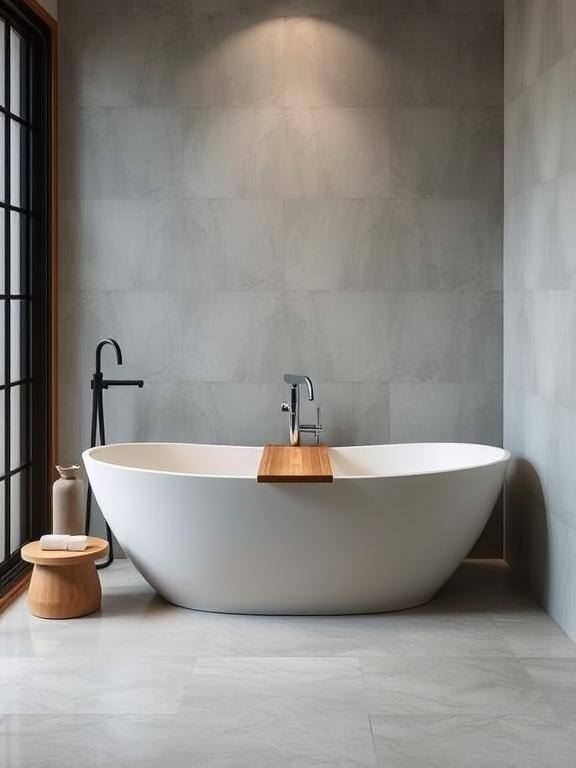
Source: Japanese Home Design
One of the most iconic elements of a Japandi bathroom is the freestanding soaking tub, a nod to Japanese bathing culture. These tubs, designed for long, relaxing soaks, are typically deep and spacious, allowing you to unwind and cleanse both your body and mind. A freestanding tub can serve as a striking focal point in your bathroom, offering both luxury and simplicity.
The beauty of a freestanding tub in a Japandi bathroom is its minimalist design. Choose a simple, clean-lined tub, such as a matte white stone version, to maintain the serene atmosphere. The tub’s form should be sleek and uncomplicated, with no ornate details or unnecessary embellishments. You can pair it with a wood or bamboo bath tray for a bit of natural texture, but avoid cluttering the space with excessive accessories.
A soaking tub not only provides a place to relax but also serves as a symbolic feature in the Japandi style—connecting you with both nature and the Japanese tradition of mindful bathing. It adds to the feeling of tranquility and balance, creating the perfect environment for self-care and relaxation.
7. Add Subtle Zen-Inspired Decor
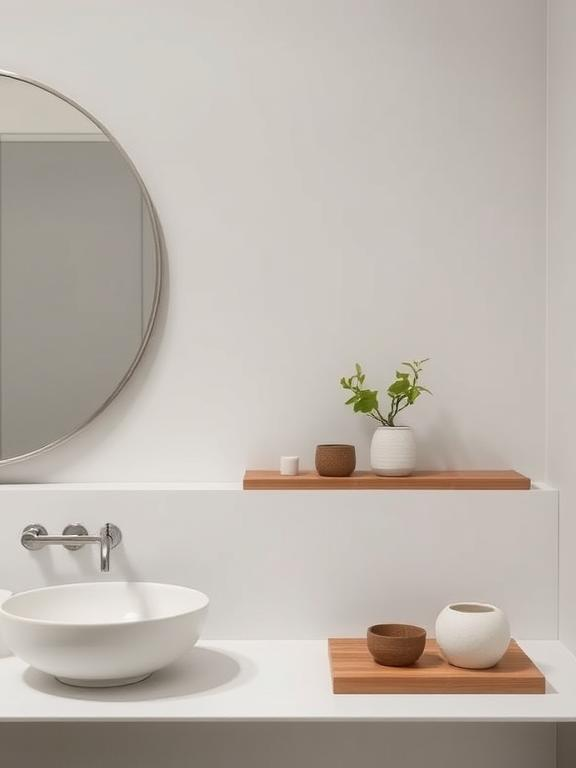
Source: Japanese Zen Living
Zen-inspired decor is a core element of Japandi design, bringing a sense of mindfulness and peacefulness to your bathroom. Simple, understated pieces like ceramic vases, minimalist sculptures, or a few select plants can elevate the space while maintaining the minimalist ethos. These accessories should feel intentional—each item in your bathroom should serve a purpose and contribute to the calming atmosphere.
When selecting decor, look for items that are either handmade or have a natural, organic feel. For example, a small, hand-thrown ceramic bowl or a delicate bamboo tray can create a serene moment within the space. You might also incorporate a few traditional Japanese items like a tea set, incense holders, or a low, wooden shelf that displays a carefully curated selection of objects.
The key to Zen decor is simplicity. The decor should never feel cluttered or forced. Instead, focus on creating an environment where each piece feels like it belongs and contributes to the overall tranquility of the room. This approach brings a sense of calm and order, essential components of Japandi style.
8. Introduce Indoor Greenery
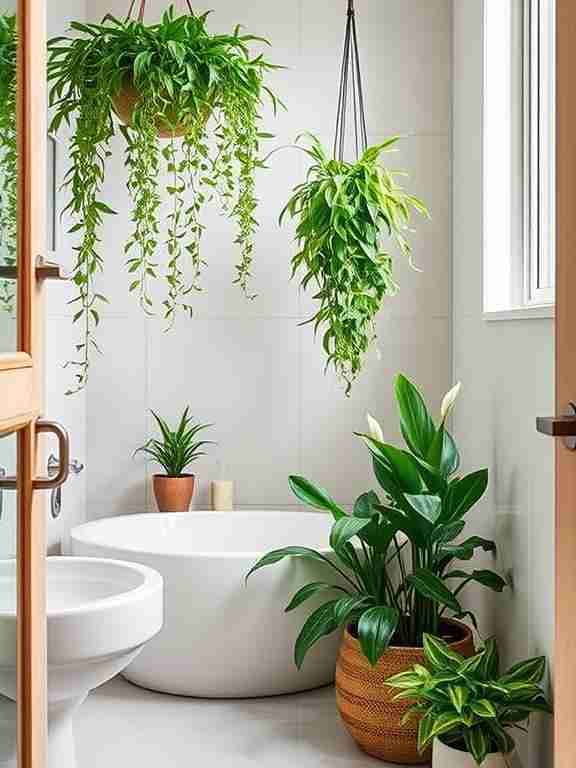
Source: Urban Greenery Design
Plants are a fantastic way to introduce life and vibrancy into a Japandi bathroom, helping to connect the space to nature. In Japandi design, plants are often used to soften the minimalist look and add an organic element to the clean lines and neutral palette. Consider using a few carefully selected plants that require minimal care and thrive in humid environments, such as ferns, bamboo, or peace lilies.
To enhance the Japandi aesthetic, choose planters that match the overall tone of the bathroom. Bamboo or wood planters work beautifully with the natural theme, while ceramic pots in earthy tones can complement the neutral color palette. Hanging plants, like ivy or pothos, are also an excellent choice for adding dimension to your space without taking up too much room.
The presence of greenery not only enhances the aesthetic appeal of your bathroom but also improves air quality, contributing to a healthier environment. It’s all about creating a balance between nature and design, and a few well-placed plants can bring your Japandi bathroom to life.
9. Maximize Natural Light & Open Space
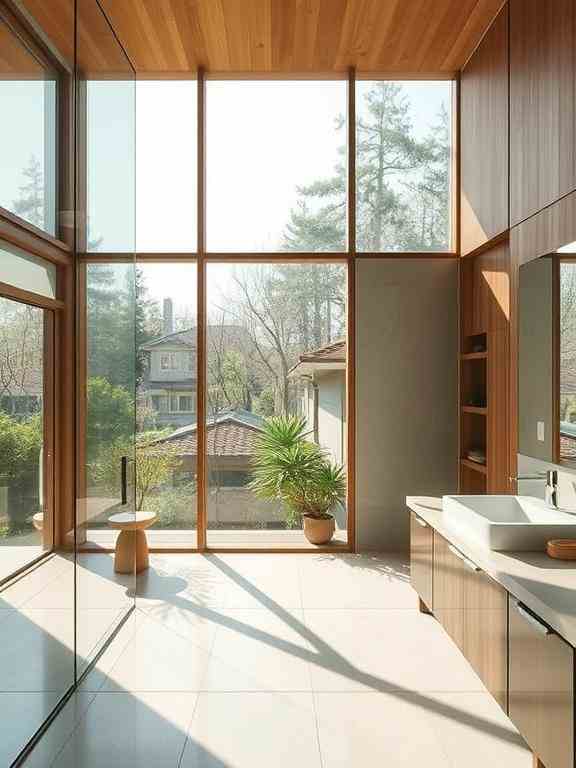
Source: Interior Architecture Daily
Natural light is essential in Japandi design, as it brings warmth, openness, and a connection to the outdoors. A Japandi bathroom should feel spacious, light-filled, and airy, so maximizing natural light is key. Large windows, skylights, or strategically placed mirrors can help achieve this effect by flooding the room with natural light and making the space feel larger and more open.
If privacy is a concern, consider using frosted glass for windows or sheer curtains to let in light while maintaining seclusion. You can also incorporate glass shower walls to allow light to flow freely throughout the space. Mirrors, especially large ones, can also be used to reflect light and visually expand the room. Choose mirrors with simple, sleek frames to maintain the minimalist vibe.
The goal is to create a space that feels open and connected to nature, with the natural light acting as a design element. A Japandi bathroom with plenty of sunlight will feel inviting, calming, and ready to help you unwind at the end of a busy day.
10. Incorporate Smart Storage Solutions
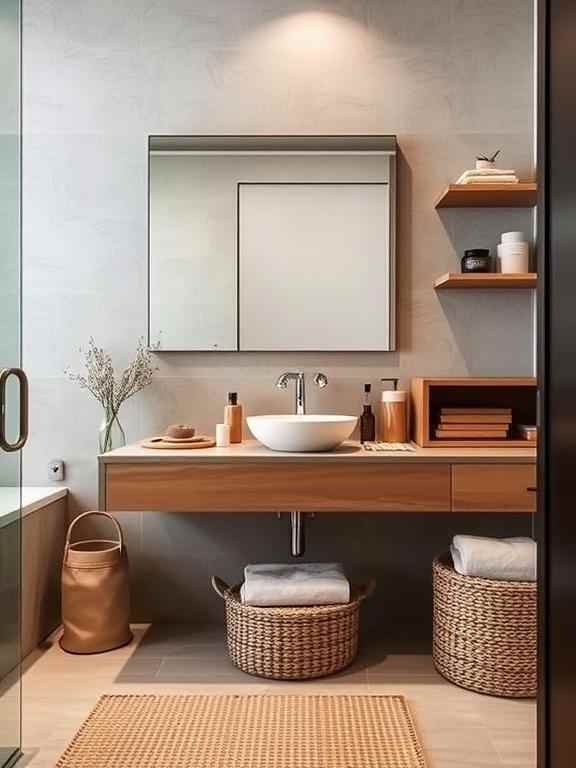
Source: Smart Home Design Ideas
In a Japandi bathroom, less is always more. Minimalism is at the heart of this style, and that means keeping clutter to a minimum. Effective storage solutions are essential for maintaining the tidy, organized atmosphere that defines Japandi design. Choose sleek, functional storage options that help keep your bathroom free from unnecessary items.
Consider wall-mounted shelving, floating vanities, or built-in cabinets to maximize space without overcrowding the room. Woven baskets, bamboo trays, or wooden boxes can serve as stylish storage options while maintaining the natural, earthy vibe. When selecting storage, focus on quality over quantity—opt for pieces that enhance the minimalist aesthetic and keep only the essentials on display.
Smart storage solutions allow you to create a bathroom that feels calm and uncluttered. By organizing your bathroom essentials in a way that aligns with the Japandi principles, you’ll create a more functional and serene space.
11. Create a Mindful, Clutter-Free Environment
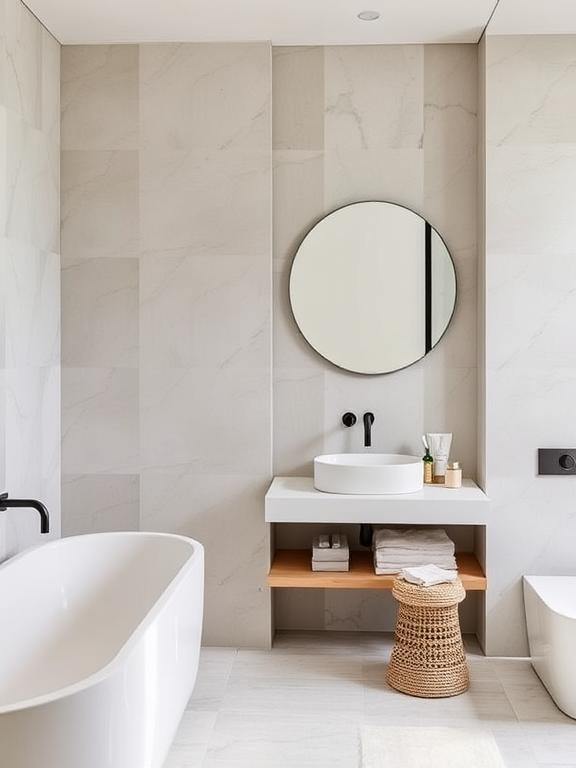
Source: Minimalist Lifestyle Tips
At the core of Japandi design is the concept of mindfulness—being intentional with every element in your space. A clutter-free bathroom is a reflection of this mindfulness, where each item has its place, and there is no room for excess. When designing your Japandi bathroom, take the time to declutter and only keep the things you truly need.
One of the best ways to achieve this is by being intentional with your design choices. Keep surfaces clear, minimize decorative items, and choose high-quality, functional pieces. Instead of filling every nook with accessories, allow empty space to breathe, creating a sense of balance and calm. Invest in elegant storage that keeps everyday items like toiletries neatly tucked away but easily accessible.
A clutter-free environment promotes mental clarity and helps foster a sense of calm. By embracing simplicity and purpose, you can create a Japandi bathroom that feels as peaceful and restorative as it looks.
Conclusion
Incorporating Japandi design into your bathroom is a fantastic way to create a serene, stylish retreat that combines minimalism with warmth and nature. From a neutral color palette and natural wood accents to the mindful choice of decor and plants, each element contributes to a space that is both functional and aesthetically pleasing.
By following these 11 Japandi bathroom ideas, you can transform your bathroom into a tranquil sanctuary where you can unwind, relax, and escape the stresses of daily life. Whether you’re planning a complete renovation or just a few small updates, the beauty of Japandi design lies in its simplicity and timelessness.
Remember, Japandi is all about balance—balancing the natural elements with clean lines, functionality with beauty. Focus on what matters most to you in your space, and don’t be afraid to add your personal touch to make it uniquely yours. Your Japandi-inspired bathroom will soon become your favorite place in your home—a true reflection of your sense of style and your need for peace.
Happy decorating!
This concludes the two-part series on creating a Japandi bathroom. Let me know if you’d like to adjust any parts or if there’s anything else you’d like to add!
